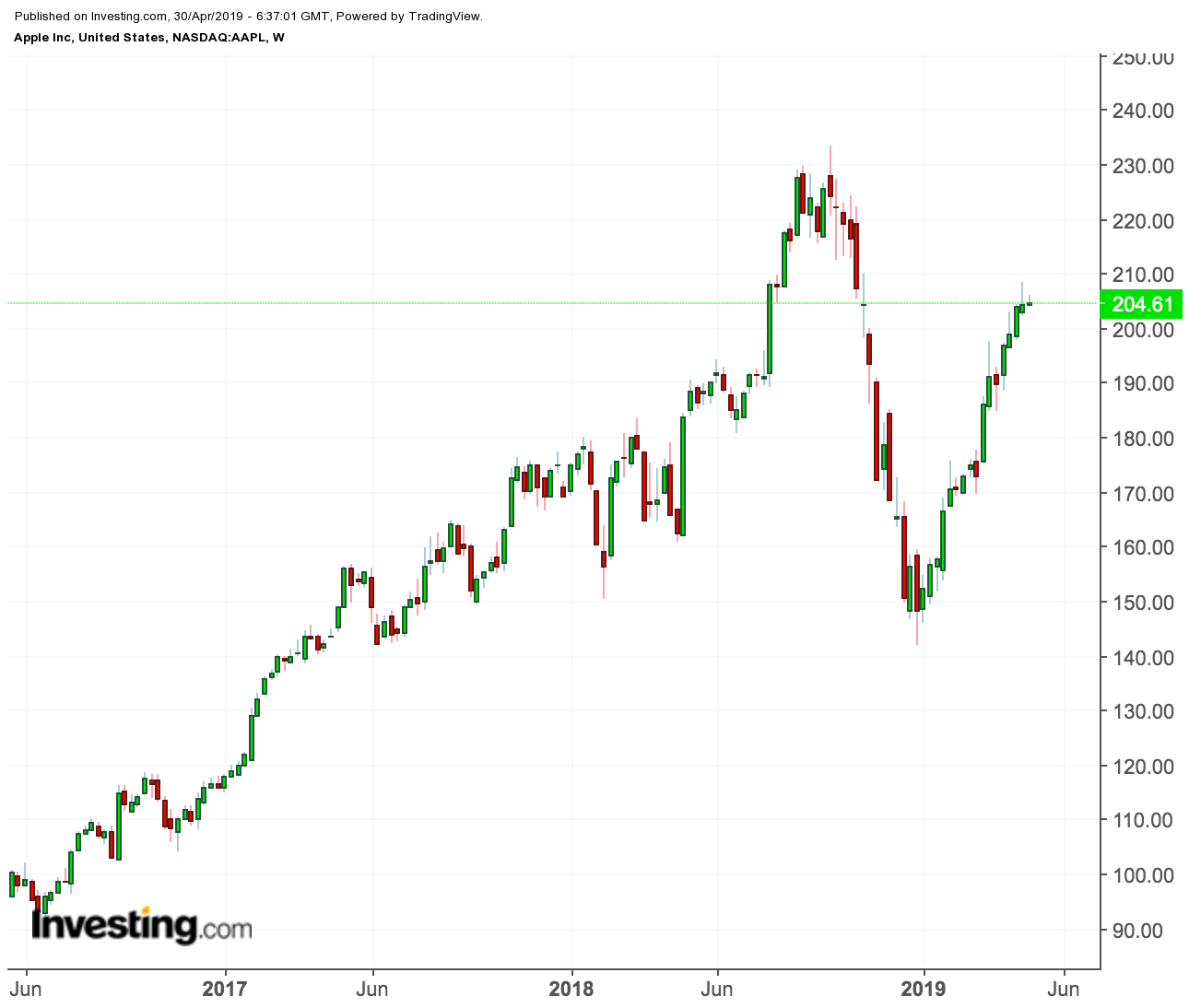* Reports Q2 2019 results on Tuesday, April 30, after the close
* Revenue expectation: $57.44B
* EPS expectation: $2.37
Investors have been feeling better about Apple Inc. (NASDAQ:AAPL) in the last few months. Its stock price has climbed 42% since hitting an 18-month low in January, closing yesterday's session up 0.2% at $204.61.
But that newly-rediscovered love will face its first big test later today when the maker of iPhones releases its second-quarter earnings. Analysts, on average, are expecting $2.37 a share profit, a 13% decline from the same period a year ago. That will be the worst year-over-year decline since 2016. Sales are likely to fall more than 6% to $57.44 billion.

Apple’s big challenge for the past several quarters has been to show that the company can sustain its growth momentum amid slowing sales of its biggest revenue generator, the iPhone. That threat became more pronounced when the company cut its revenue forecast for the first time in more than 15 years in January, citing a sharp slowdown in China. Later that month, Apple posted its first holiday quarter decline in revenue and profit in over a decade.
Coupled with this lackluster sales forecast for China, Apple is facing a different challenge in its developed markets: iPhone’s loyal customers are sticking with their older models and taking more time to buy the more expensive, newer phones.
Services Are Apple’s New Ammunition
No doubt, this grim outlook provides enough reason for many analysts to slash their forecasts and raise questions about the company’s future outlook. But we believe these challenges are short-term and CEO Tim Cook has sufficient ammunition with which to fight this downturn cycle. We derive our optimism from the company’s biggest push so far to monetize its 1.4-billion active-installed base by offering a suite of new services.
In a major shift to its growth strategy, Apple in March announced a new video-subscription service that will offer its own original content. It also plans to launch a mobile gaming subscription service offering access to 100-plus exclusive games, as well as an Apple credit card in partnership with Goldman Sachs Group (NYSE:GS).
The most important part of this strategic shift is Apple’s foray into the video-streaming service, which it plans to launch in over 100 countries this fall. On the consumer finance side, Apple Card won’t have common charges such as annual, foreign-transaction and late fees, further increasing the appeal of its Apple Pay feature.
It’s hard to predict how long it will take for Cook to start making money from these new attractions, but it’s not difficult to see a future where Apple becomes a service-based company, while its mature iPhone business continues to provide cash.
Even before the March announcement, strong performances from the company’s other businesses was diminishing Apple’s iPhone dependency. The company’s services section, which includes Apple Music, movie rentals and app downloads, produced 33% growth last year with sales touching $40 billion—accounting for about 15% of the company’s total of $265.6 billion sales. That contribution to Apple’s total revenue, according to an estimate by Morgan Stanley, will continue to grow and could generate about 60% of Apple’s revenue in the next five years.
Apple’s growing cash-return to investors is another compelling reason to remain loyal to the stock. Apple returned more than $12 billion to investors in the December quarter in the shape of dividends and share buyback. That amount is likely to grow, especially when Apple’s cash-hoard is swelling. The company ended last year with a net cash balance of $130 billion.
Bottom Line
We don’t think the rough period for Apple’s iPhone sales is over. The Q2 earnings are likely to show that trend. But these headwinds are short-term and we believe any weakness post earnings report should be taken as a buying opportunity.
We don’t think Apple stock is expensive even after this year’s rally. Apple is trading at about 16 times forward earnings estimates, compared with an average of about 20 times for the S&P 500 Information Technology Index. For long-term investors whose objective is to earn a decent return through dividends and capital appreciation, we still find Apple offering an attractive risk-reward preposition.
